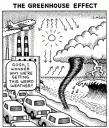How much carbon dioxide is produced by driving a car on one tank of petrol?
 Petrol is a mixture of several different organic carbon compounds. The most common molecules in petrol are the alkanes, consisting of straight or branched carbon chains with between 5-8 carbon atoms saturated with hydrogen molecules (pentane, hexane, heptane and octane).
Petrol is a mixture of several different organic carbon compounds. The most common molecules in petrol are the alkanes, consisting of straight or branched carbon chains with between 5-8 carbon atoms saturated with hydrogen molecules (pentane, hexane, heptane and octane).
This is the chemical formula for the complete combustion of octane:
2 C8H18 + 25 O2 = 18 H2O + 16 CO2
As you can see from this simple equation, for every single octane molecule that is burned, 8 molecules of CO2 are produced. The standard unit measure of compounds is the mole. 1 mole of octane weighs 114 grams and contains avogadro’s number of molecules, 6.023 x 1023. 1 mole of CO2gas weighs 44 grams, but takes up much more volume. It’s important to remember from the ideal gas law that at standard laboratory conditions (25°C and 1 atmosphere pressure) one mole of gas at occupies 24.5 litres. One litre of petrol contains ~737.22 grams of liquid (or ~6.47 moles). Therefore, when one litre of petrol is burned, 2.28kg of CO2 are produced, equivalent to 1268 litres of of CO2 gas!! Every single 50 litre tank full of petrol will produce over 63,400 litres of CO2 gas (63.4 m3), or a volume equivalent to an imaginary cube with sides 4 metres long.
I find it interesting that people talk in terms of kilograms of CO2 because it really underestimates the quantity of gas we’re dealing with. Gases weigh hardly anything! In fact, 1kg of CO2 equals 557 litres! Why don’t we learn to quote the data figures of CO2 in litres instead? How much petrol must be burned to get 1kg of CO2 gas? The answer is that only 324 grams of petrol will yield 1 kg of CO2.
However, this is the chemical equation for a ‘complete combustion’ reaction of octane, meaning that it assumes there is an abundance of oxygen in the atmosphere and that no other byproducts such as carbon monoxide are produced. It’s a simple equation, but real life is more complicated, so below is a more advanced chemical equation taking into account the nitrogen in the atmosphere. 2
2 C8H18 + 25(O2 + 3.76N2)= 18 H2O + 16 CO2 +94N2
Taking this further, when an internal combustion engine is «running rich», we get incomplete combustion in which carbon monoxide (CO) and molecular hydrogen (H2) are byproducts of the reaction, along with other gases of nitrogen. Here is the unbalanced equation occuring at high temperature:
C8H18 + O2 + N2 = H2O + CO2 + N2 + O2 + CO + H2 + H + O + OH + NO+ N
A advanced link to combustion theory can be read here. Things get substantially more complicated when the flame kinetics & high temperatures of an exothermic reaction are taken into account, as the products are able to break down & react with eachother. This is an online application for determining the products of reaction of popular hyrdrocarbon fuels at elevated temperatures and pressures. Other compounds such as SO2 are also produced from the oxidisation of sulphur impurities in petrol.






hi,
I very much enjoyed your article above as I’m researching to launch a business in the green arena… I was intrigued to read that 324 grams of petrol will yield 1 kg of CO2… it seemed strange that more mass could result from the initial amount of petrol… does this occur due to the mass of the large mass (or volume) of O2 thats contributes (reacts) with the petrol? What an eye opener! thanks for your reply..(in advance)
the reason why it is quoted in kg is obviously the fact that volume depends on temperature, so if you quote a volume you MUST quote a temperature otherwise the number is useless.
Mass is temperature independent. Therefore, I believe it’s more than fine -in other words, correct- to quote the values in kg.